1997 CHEVROLET CORVETTE inflation pressure
[x] Cancel search: inflation pressurePage 145 of 356
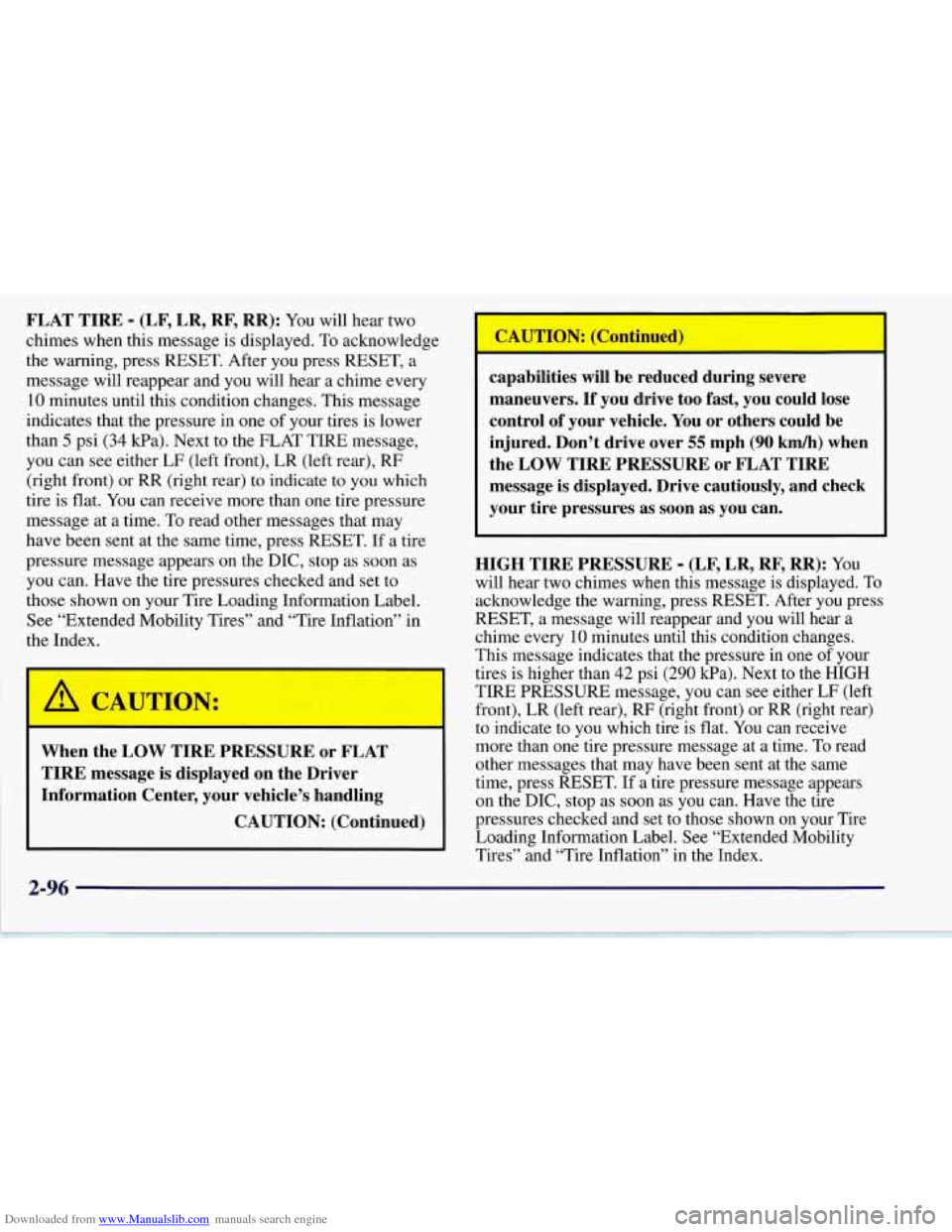
Downloaded from www.Manualslib.com manuals search engine FLAT TIRE - (LF, LR, RF, RR): You will hear two
chimes when this message is displayed. To acknowledge
the warning, press RESET. After you press RESET, a
message will reappear and you will hear a chime every
10 minutes until this condition changes. This message
indicates that the pressure in one of your tires is lower
than
5 psi (34 Wa). Next to the FLAT TIRE message,
you can see either LF (left front), LR (left rear),
RF
(right front) or RR (right rear) to indicate to you which
tire is flat. You can receive more than one tire pressure
message at a time. To read other messages that may
have been sent at the same time, press RESET. If a tire
pressure message appears on the DIC, stop as soon
as
you can. Have the tire pressures checked and set to
those shown on your Tire Loading Information Label.
See “Extended Mobility Tires” and “Tire Inflation” in
the Index.
When the LOW TIRE PRESSURE or FLAT
TIRE message is displayed on the Driver
Information Center, your vehicle’s handling
CAUTION: (Continued)
I
capabilities will be reduced during severe
maneuvers. If you drive too fast, you could lose control of your vehicle.
You or others could be
injured. Don’t drive over
55 mph (90 km/h) when
the LOW TIRE PRESSURE or FLAT TIRE
message is displayed. Drive cautiously, and check
your tire pressures as soon as
you can.
HIGH TIRE PRESSURE
- (LF, LR, RF, RR): YOU
will hear two chimes when this message is displayed. To
acknowledge the warning, press RESET. After you press
RESET, a message will reappear and you will hear a
chime every
10 minutes until this condition changes.
This message indicates that the pressure in one of your
tires is higher than 42 psi (290 Wa). Next to the HIGH
TIRE PRESSURE message, you can see either LF (left
front), LR (left rear),
RF (right front) or RR (right rear)
to indicate to you which tire is flat. You can receive
more than one tire pressure message at a time. To read
other messages that may have been sent at the same
time, press RESET. If a tire pressure message appears
on the DIC, stop as soon as you can. Have the tire
pressures checked and set to those shown on your Tire
Loading Information Label. See “Extended Mobility
Tires” and “Tire Inflation’’ in the Index.
Page 209 of 356
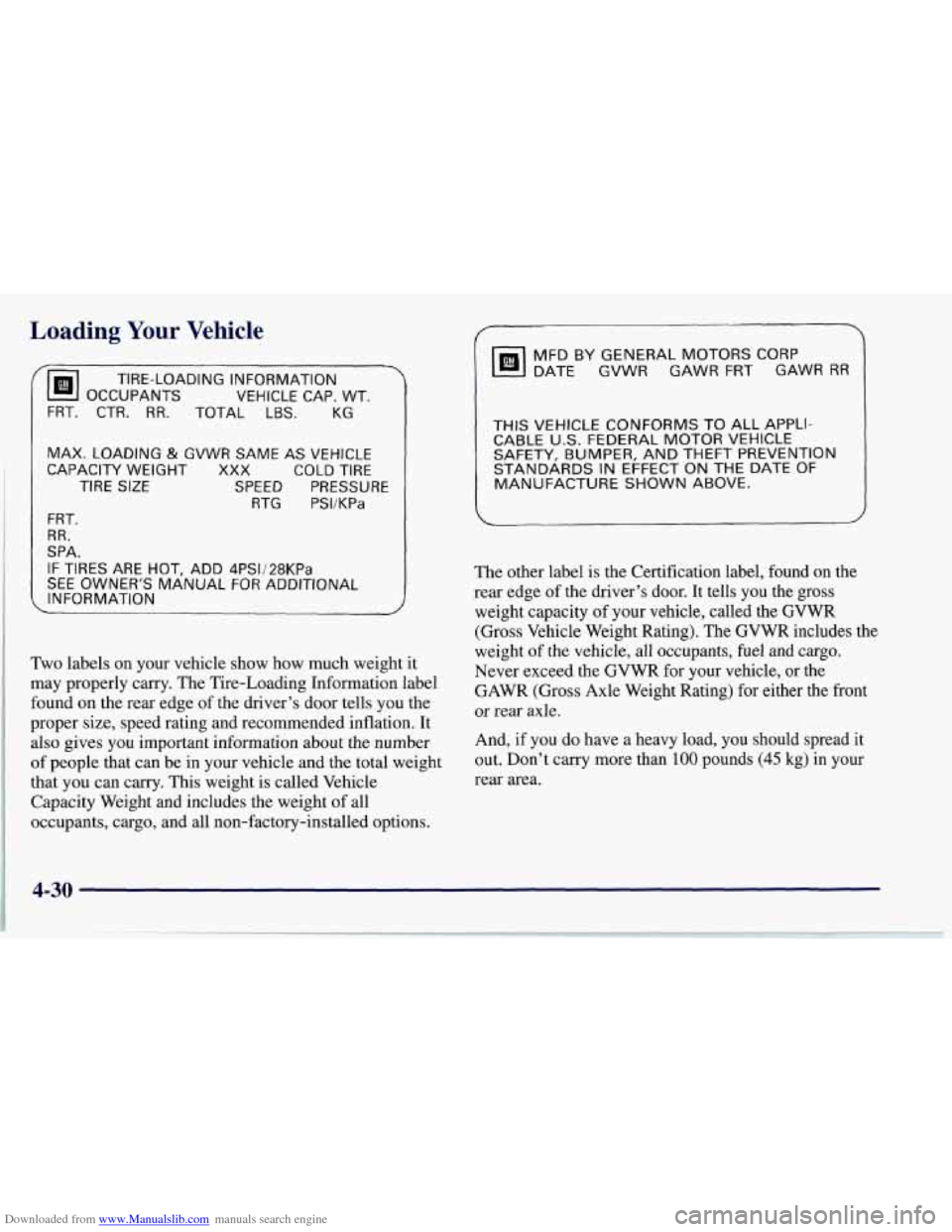
Downloaded from www.Manualslib.com manuals search engine Loading Your Vehicle
/ -
OCCUPANTS VEHICLE CAP. WT.
TIRE-LOADING INFORMATION
FRT. CTR.
RR. TOTAL LBS. KG
MAX.
LOADING & GVWR SAME AS VEHICLE
CAPACITY WEIGHT
XXX COLD TIRE
TIRE SIZE SPEED PRESSURE
RTG
PSI/KPa
FRT. RR.
SPA. IF
TIRES ARE HOT, ADD 4PS1/28KPa
SEE OWNER’S MANUAL FOR ADDITIONAL
INFORMATION
Two labels on your vehicle show how much weight it
may properly carry. The Tire-Loading Information label
found on the rear edge of the driver’s door tells you the
proper size, speed rating and recommended inflation. It
also gives you important information about the number
of people that can be in your vehicle and the total weight
that you can carry. This weight is called Vehicle
Capacity Weight and includes the weight of all
occupants, cargo, and all non-factory-installed options.
DATE GVWR GAWR FRT GAWR RR
MFD BY GENERAL MOTORS CORP
THIS VEHICLE CONFORMS TO ALL APPLI-
CABLE U.S. FEDERAL MOTOR VEHICLE
SAFETY, BUMPER, AND THEFT PREVENTION
STANDARDS
IN EFFECT ON THE DATE OF
MANUFACTURE SHOWN ABOVE.
The other label is the Certification label, found on the
rear edge of the driver’s door. It tells you
the gross
weight capacity of your vehicle, called the GVWR
(Gross Vehicle Weight Rating).
The GVWR includes the
weight
of the vehicle, all occupants, fuel and cargo.
Never exceed the GVWR for your vehicle, or the
GAWR (Gross Axle Weight Rating) for either the front
or rear axle.
And,
if you do have a heavy load, you should spread it
out. Don’t carry more than
100 pounds (45 kg) in your
rear area.
4-30
Page 275 of 356
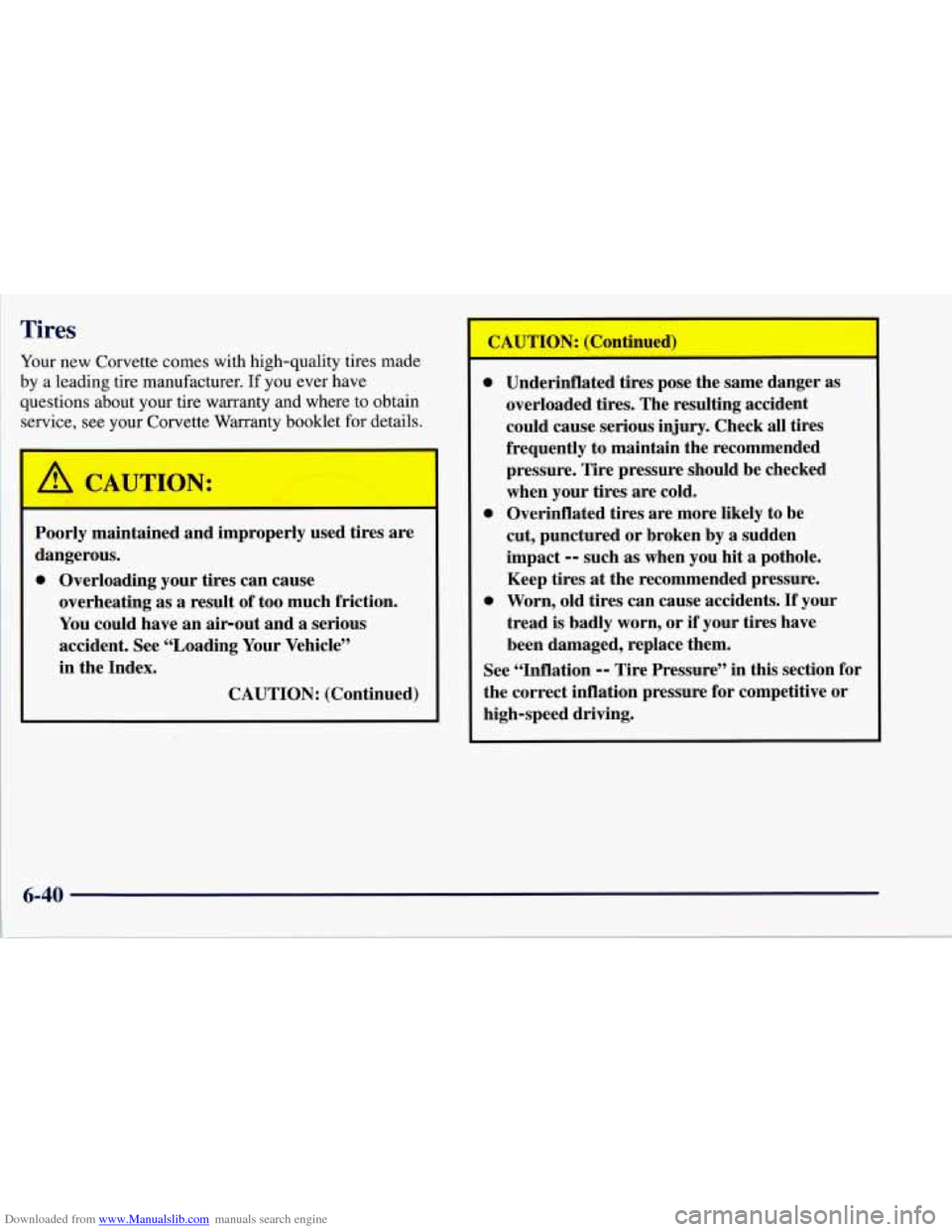
Downloaded from www.Manualslib.com manuals search engine Tires
Your new Corvette comes with high-quality tires made
by a leading tire manufacturer. If you ever have
questions about your tire warranty and where to obtain
service, see your Corvette Warranty booklet for details.
Poorly maintained and improperly used tires are
dangerous.
0 Overloading your tires can cause
overheating as a result of too much friction.
You could have an air-out and a serious
accident. See “Loading Your Vehicle”
in the Index.
CAUTION: (Continued)
0
0
0
See “Inflation
Underinflated tires
pose the same danger as
overloaded tires. The resulting accident could cause serious injury. Check all tires
frequently to maintain the recommended
pressure. Tire pressure should be checked
when your tires are cold.
Overinflated tires are more likely to be
cut, punctured or broken by a sudden
impact
-- such as when you hit a pothole.
Keep tires
at the recommended pressure.
Worn, old tires can cause accidents.
If your
tread is badly worn, or if your tires have
been damaged, replace them.
-- Tire Pressure” in this section
the correct inflation pressure for competitive or
high-speed driving.
Page 276 of 356
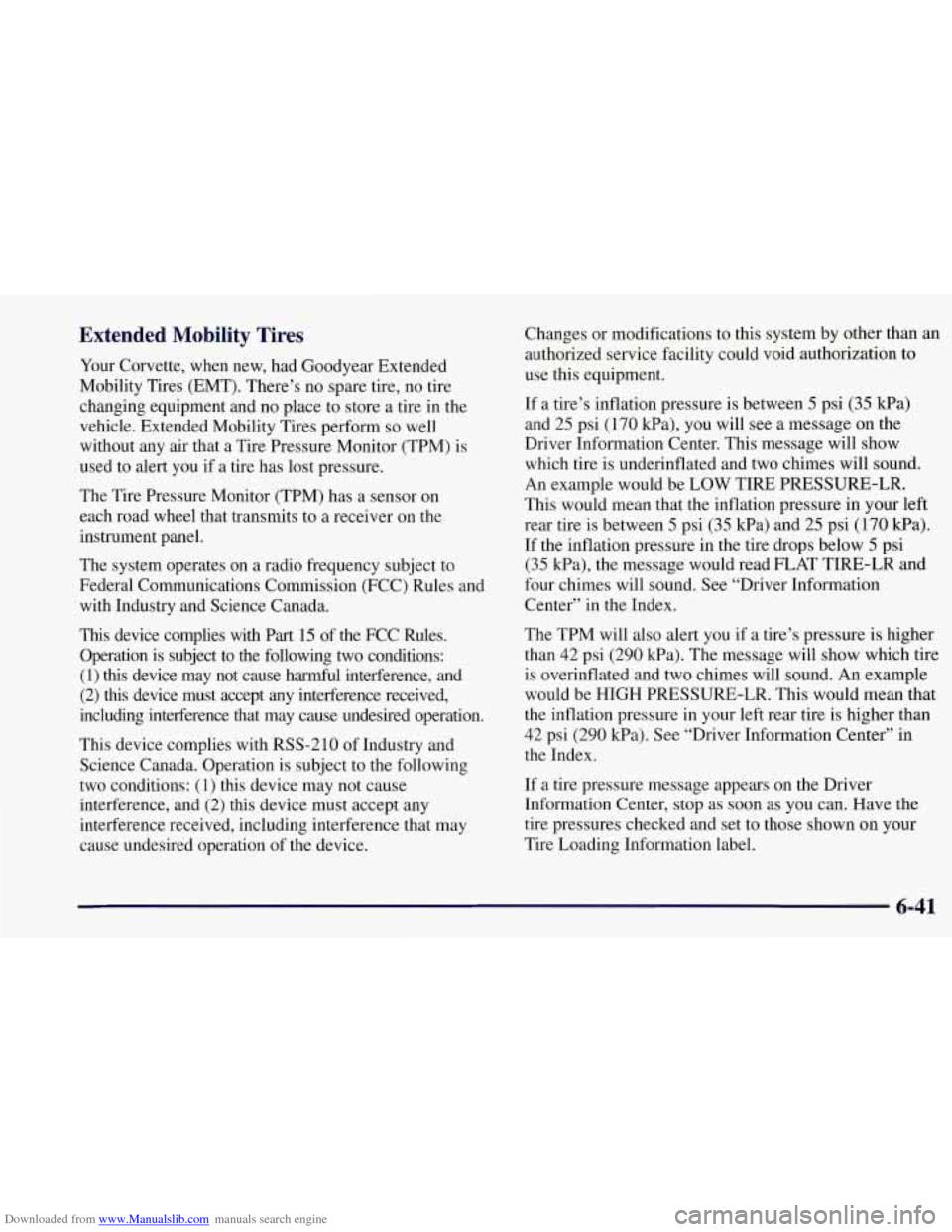
Downloaded from www.Manualslib.com manuals search engine Extended Mobility Tires
Your Corvette, when new, had Goodyear Extended
Mobility Tires (EMT). There’s no spare tire, no tire
changing equipment and no place to store a tire in the
vehicle. Extended Mobility Tires perform
so well
without any air that a Tire Pressure Monitor (TPM) is
used to alert you if a tire has lost pressure.
The Tire Pressure Monitor (TPM) has a sensor on
each road wheel that transmits to a receiver on the
instrument panel.
The system operates on a radio frequency subject to
Federal Communications Commission (FCC) Rules and with Industry and Science Canada.
This device complies with Part 15 of the FCC Rules.
Operation is subject to the following two conditions:
(1)
this device may not cause harmful interference, and
(2) this device must accept any interference received,
including interference that may cause undesired operation.
This device complies with RSS-210 of Industry and
Science Canada. Operation is subject to the following
two conditions:
(1) this device may not cause
interference, and (2) this device must accept any
interference received, including interference that may
cause undesired operation of the device. Changes
or modifications to this system by other than an
authorized service facility could void authorization to
use this equipment.
If a tire’s inflation pressure is between
5 psi (35 kPa)
and 25 psi
(170 kPa), you will see a message on the
Driver Information Center. This message will show
which tire is underinflated and two chimes will sound.
An example would be LOW TIRE PRESSURE-LR.
This would mean that the inflation pressure in your left
rear tire is between
5 psi (35 Pa) and 25 psi (170 Wa).
If the inflation pressure in the tire drops below
5 psi
(35 kPa), the message would read FLAT TIRE-LR and
four chimes will sound. See “Driver Information
Center” in the Index.
The TPM will also alert you if a tire’s pressure is higher
than 42 psi (290 kPa). The message will show which tire
is overinflated and two chimes will sound. An example
would be
HIGH PRESSURE-LR. This would mean that
the inflation pressure in your left rear tire is higher than
42 psi
(290 Wa). See “Driver Information Center” in
the Index.
If a tire pressure message appears
on the Driver
Information Center, stop as soon as you can. Have the
tire pressures checked and set to those shown on your
Tire Loading Information label.
6-41
Page 278 of 356
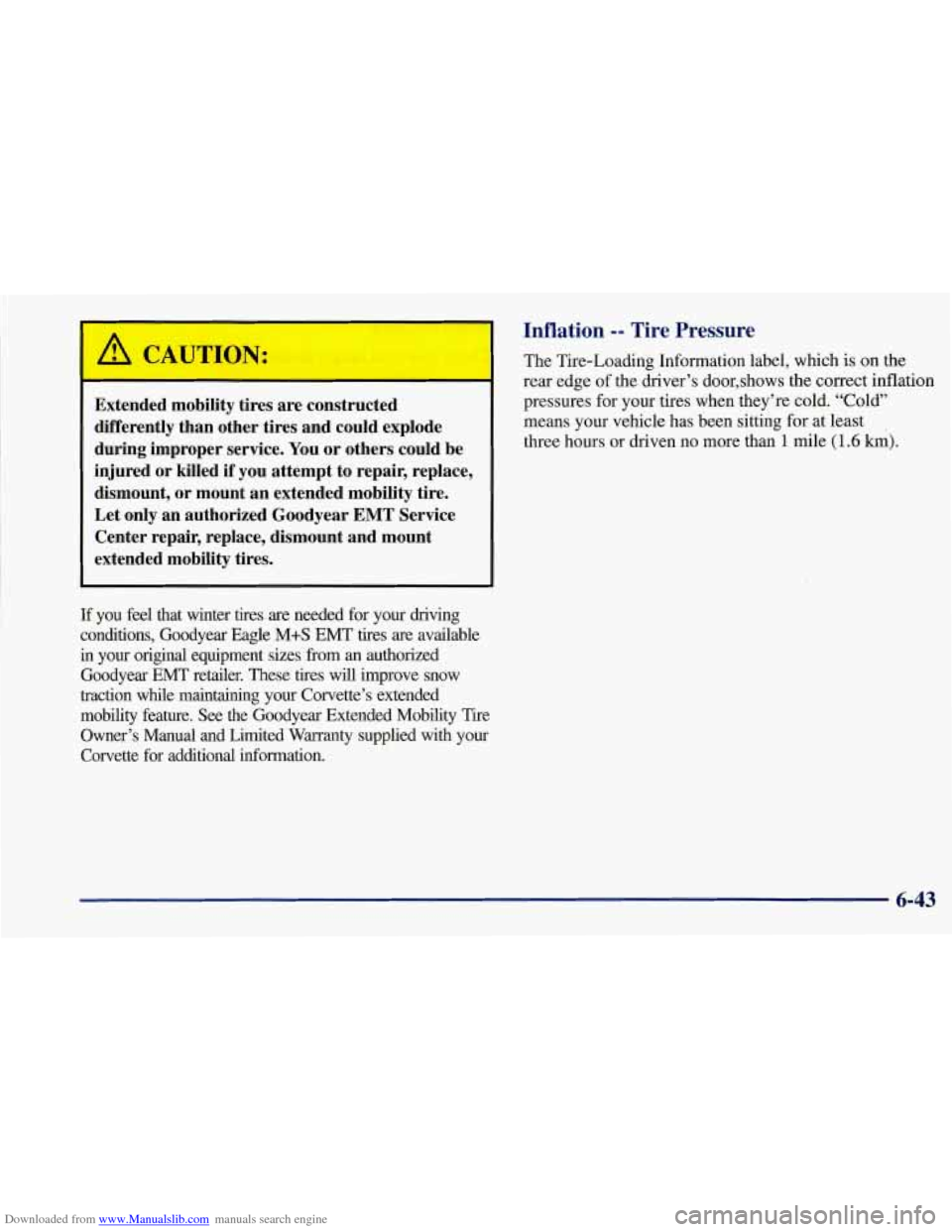
Downloaded from www.Manualslib.com manuals search engine Extended mobility tires are constructed
differently than other tires and could explode
during improper service. You or others could be
injured or killed
if you attempt to repair, replace,
dismount,
or mount an extended mobility tire.
Let only an authorized Goodyear
EMT Service
Center repair, replace, dismount and mount
extended mobility tires.
If you feel that winter tires are needed for your driving
conditions, Goodyear Eagle
M+S EMT tires are available
in your original equipment sizes fi-om an authorized
Goodyear EMT retailer. These tires will improve snow traction while maintaining your Corvette’s extended
mobility feature. See
the Goodyear Extended Mobility Tire
Owner’s Manual and Limited Warranty supplied with your
Corvette for additional information.
Inflation -- Tire Pressure
The Tire-Loading Information label, which is on the
rear edge
of the driver’s door,shows the correct inflation
pressures for
your tires when they’re cold. “Cold”
means your vehicle has been sitting for at least
three hours
or driven no more than 1 mile (1.6 km).
6-43
Page 279 of 356

Downloaded from www.Manualslib.com manuals search engine NOTICE:
Don’t let anyone tell you that underinflation or
overinflation
is all right. It’s not. If your tires
don’t have enough air (underinflation), you can
get the following:
0 Too much flexing
0 Too much heat
0 Tire overloading
0 Bad wear
Bad handling
0 Bad fuel economy.
If your tires have too much air (overinflation),
you can get the following:
Unusual wear
0 Bad handling
Rough ride
0 Needless damage from road hazards. When to Check
Check your tires
once a month or more.
How to Check
Use a good quality pocket-type gage to check tire
pressure.
You can’t tell if your tires are properly inflated
simply by looking at them. Radial tires may look
properly inflated even when they’re underinflated.
Be sure
to put the valve caps back on the valve stems.
They help prevent leaks by keeping out
dirt and moisture.
Tire Rotation
The tires on your Corvette are directional and are
different sizes front to rear. Due to this, your tires should
not be rotated. Each tire and wheel should be used only
in the position it is in.
6-44
Page 320 of 356
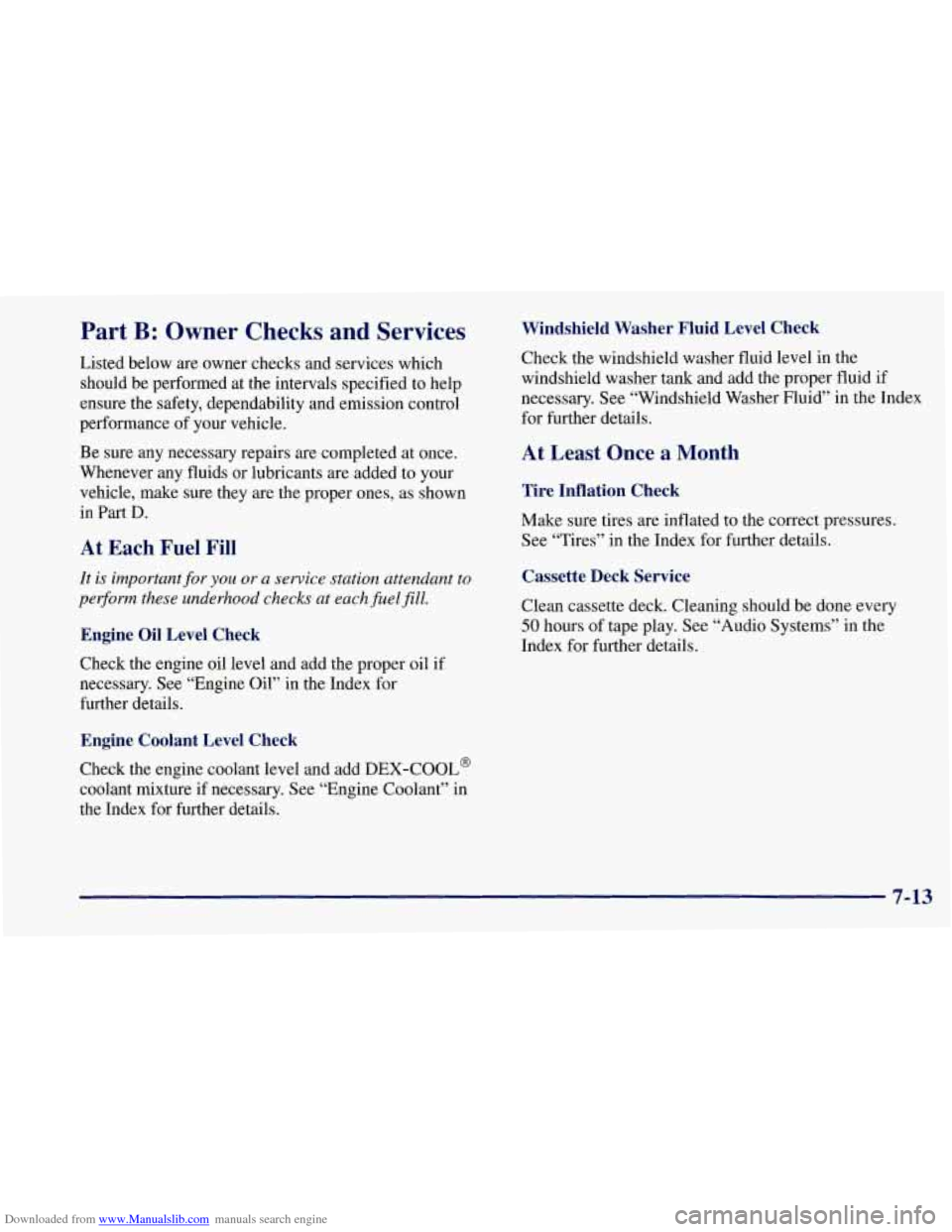
Downloaded from www.Manualslib.com manuals search engine Part B: Owner Checks and Services
Listed below are owner checks and services which
should be performed at the intervals specified to help
ensure the safety, dependability and emission control
performance
of your vehicle.
Be sure any necessary repairs are completed at once.
Whenever any fluids
or lubricants are added to your
vehicle, make sure they are the proper ones, as shown
in Part
D.
At Each Fuel Fill
It is important for you or a service station attendant to
per$orm these underhood checks at each fuel
fill.
Engine Oil Level Check
Check the engine oil level and add the proper oil if
necessary. See “Engine Oil” in the Index for
further details.
Engine Coolant Level Check
Check the engine coolant level and add DEX-COOL@
coolant mixture
if necessary. See “Engine Coolant” in
the Index for further details.
Windshield Washer Fluid Level Check
Check the windshield washer fluid level in the
windshield washer tank and add the proper fluid if
necessary. See “Windshield Washer Fluid” in the Index
for further details.
At Least Once a Month
Tire Inflation Check
Make sure tires are inflated to the correct pressures.
See “Tires” in the Index for further details.
Cassette Deck Service
Clean cassette deck. Cleaning should be done every
50 hours of tape play. See “Audio Systems” in the
Index for further details.
7-13
Page 348 of 356

Downloaded from www.Manualslib.com manuals search engine Fiberglass Springs .............................. 6-58
Fifth Gear. Manual Transmission
................... 2-29
Filling Your Tank
................................ 6-5
Filter. Air Cleaner
.............................. 6- 16
Finish Care
.................................... 6-56
Finish Damage
................................. 6-57
First Gear. Automatic Transmission
................ 2-28
First Gear. Manual Transmission
................... 2-29
Flashers. Hazard Warning
......................... 5-2
Flat Tire. What to
Do ............................ 5-22
Floor Mats
.................................... 2-60
Fluid Capacities
................................ 6-70
FobTraining
................................... 2-89
Foreign Countries, Fuel
........................... 6-5
Fourth Gear. Manual Transmission
................. 2-29
French Language Manual
11
Front Sidemarker Lamp Bulb Replacement ........... 6-35
Front Turn Signal Lamp Bulb Replacement
.......... 6-35
Fuel
.......................................... 6-3
Canada
...................................... 6-4
In Foreign Countries
........................... 6-5
Fuel. Filling Your Tank
........................... 6-5
Fuses and Circuit Breakers
....................... 6-63
Gages
FogLamps
.................................... 2-51
.. ...........................
FrontTowing .................................. 5-10
Gage ....................................... 2-80
Engine Coolant Temperature
.................... 2-75
Engine Oil Pressure
........................... 2-78
Fuel
....................................... 2-81
Voltmeter
................................... 2-73 GAWR
.................................. 4.30. 4.31
Gear Positions
................................. 2-26
Gross Axle Weight Rating
................... 4.30. 4.31
Gross Vehicle Weight Rating
................. 4.30. 4-31
Guide en Franpis
11
GVWR .................................. 4.30. 4.31
Halogen Bulbs
................................ 6-33
Hazard Warning Flashers
.......................... 5-2
Headlamp Doors
............................... 2-44
Headlamp/Highbeams Bulb Replacement
............ 6-33
Headlamps
.................................... 2-43
Wiring
..........................................
Hearing Impaired, Customer Assistance .............. 8-4
Heating
....................................... 3-12
High-Beam Lamps
.............................. 2-45
Highway Hypnosis
............ ............... 4-24
Hill and Mountain Roads
..... ............. 4-24
Hood
Checking Things Under
...... .............. 6-8
Release
.................................... 6-8
Horn
......................................... 2-40
Hydraulic Clutch
............................... 6-20
Hydroplaning
.......................... ... 4-20
.. .................................
HighLow Beamchanger ...................... 2-45
Heritage Pages
111 ... ...................................
Ignition Switch .............. ............... 2-20
Inadvertent Load Control
....... ............... 2-53
Inflation. Tire
.................................. 6-43
Inside Daymight Rearview Mirror
................. 2-53
9-5